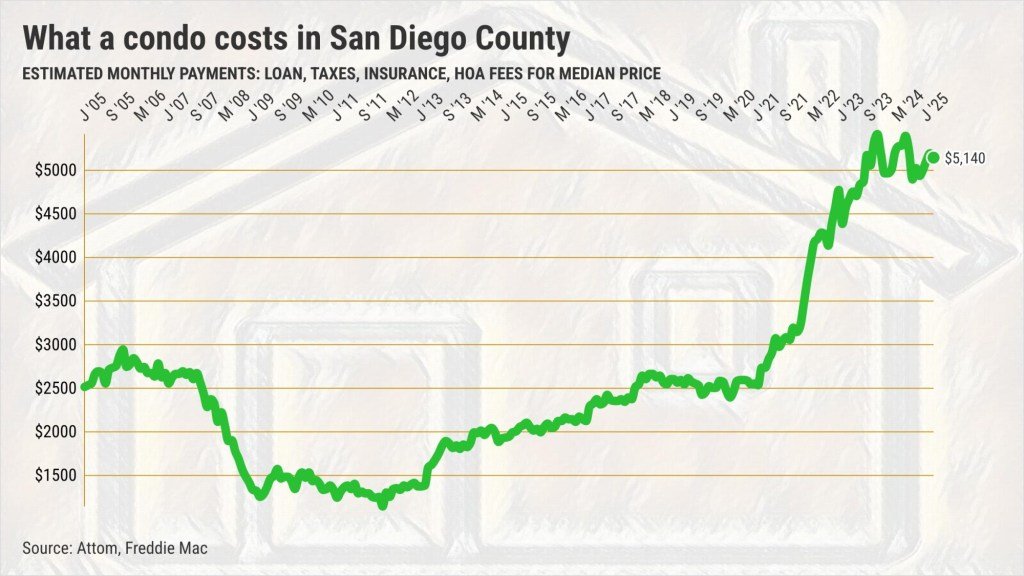You’d need to earn $154,200 annually to comfortably finance the purchase of the typical San Diego County condo.
As the sun bathes the Pacific coastline, prospective homebuyers flock to San Diego, drawn by its balmy climate and vibrant culture. However, beneath the allure lies a stark reality: the median price of a condo has reached a staggering $690,000. For many, this is not just a steep price but a barrier that reflects broader societal changes and economic challenges.
The Cost of Homeownership
The financial strain becomes evident upon analyzing the numbers. In March 2025, various data sources—including Attom, which tracks property sales, and Freddie Mac’s mortgage statistics—paint a clear picture of the financial landscape. A typical San Diego County condo is now valued 60% higher than it was six years ago, with prices increasing by 2% in just the last year. Such statistics lead to a daunting conclusion: to afford this so-called “bargain” of homeownership, one needs an annual income of $154,200.
Breaking Down the Numbers
Understanding this financial hurdle requires a meticulous examination of housing costs, interest rates, and additional expenses:
- Price Tag: The median sales price for condos in March was $690,000, reflecting substantial market growth.
- Interest Rates: The average mortgage rate stood at 6.82%, marginally rising from 6.75% a year earlier and significantly higher than the 4.37% rate seen six years ago.
- Repayment Calculation: Assuming a 10% down payment, the monthly mortgage repayment is calculated at approximately $4,220.
Additional Costs and True Ownership
Homeownership goes far beyond the monthly mortgage payment. There are crucial extra costs that potential buyers must account for:
- Down Payment: The cash needed upfront (in this case, $69,000) is a significant hurdle.
- Other Costs: Property taxes, insurance, and homeowners association dues can add another $920 monthly, bringing the total to $5,140.
In the world of real estate, the financial burden can be inescapably heavy. As Dr. Linda Rowe, a housing economist at the University of California, San Diego, explains, “The increasing costs are not just about personal finances; they reflect systemic issues in the housing market that require urgent attention from policymakers.”
The Income Threshold
To put this financial challenge into further perspective, a household must earn at least $154,200 to qualify for a condo, assuming that 40% of their income will go towards housing costs. This represents a staggering 98% increase compared to six years ago. Other counties in Southern California reveal the widening chasm between incomes and housing prices:
- Orange County: $189,000 for a condo priced at $845,000.
- Los Angeles County: $162,300 for a $725,000 condo.
- Ventura County: $142,800 for a $639,500 condo.
- San Bernardino County: $132,000 for a $589,250 condo.
- Riverside County: $119,400 for a $535,000 condo.
The House Gap
The disparity between owning a condo and a single-family home becomes even starker when one considers that March’s median home price in San Diego County was $1.03 million, requiring an income of $204,600. The additional financial burden presents an insurmountable challenge for many families, forcing potential buyers to make difficult choices.
According to Dr. Edwin Lau, a sociologist at the California Institute for Home Economics, “The increasing house gap contributes to a cycle of affordability issues, particularly affecting marginalized communities and first-time buyers.” His research indicates that this gap has real implications for social structures, including family stability and community cohesion.
Conclusion: Navigating the Landscape
The quest for homeownership in San Diego epitomizes the struggle many faced in contemporary America—a pursuit clouded by soaring prices and stagnant incomes. With increasing mortgage rates and property values, the dream of owning a home can feel more like a mirage, perpetually out of reach for a growing number of residents. As we survey this landscape, one thing remains clear: significant change is necessary to address the widening gap in housing affordability. Until then, many will continue to bear the weight of a financial burden that feels heavier with each passing year.









